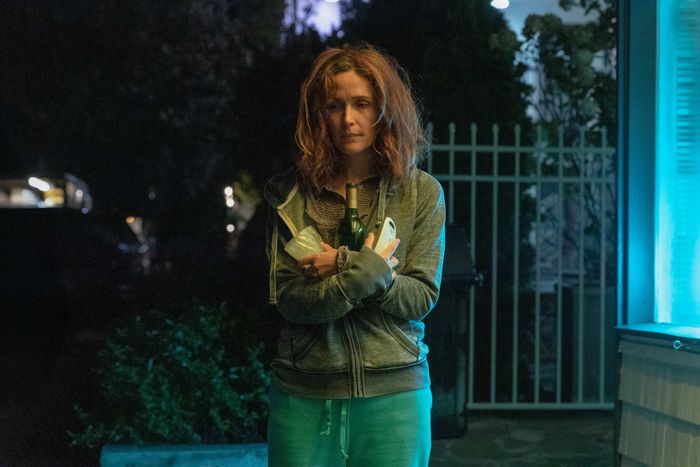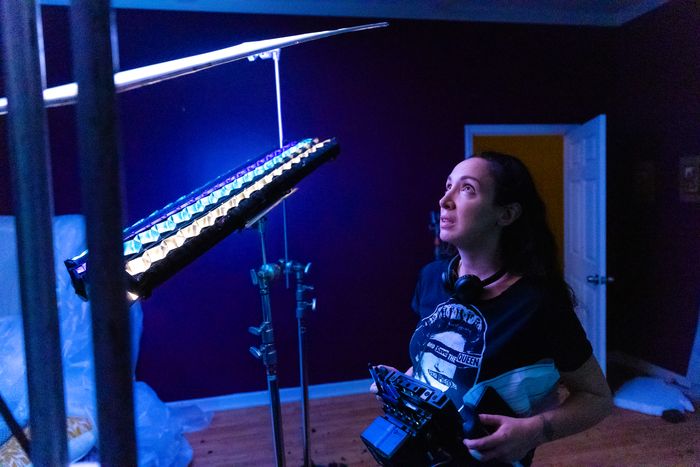
Spoilers ahead for the plot and ending of If I Had Legs I’d Kick You.
Mary Bronstein’s first movie, the acerbic 2008 comedy Yeast, co-starring Greta Gerwig, came and went with little fanfare. In her eyes, it was a wrong-time situation: No one was eager to engage with what she calls the film’s “aggression” or its objectionable characters. But 17 years later, moods have shifted. Bronstein’s second movie, If I Had Legs I’d Kick You, is being embraced for its aggression. “It’s because people are angry,” she says. “They’e overwhelmed, and they want to see that reflected back.”
The final act in particular is a frenzy of anger. Over the preceding hour, we’ve seen Linda (Rose Byrne) hit a near-comical breaking point in every area of her life — her sick daughter’s unrelenting needs, her absent husband’s rebukes, her landlord’s nonchalance about the gaping hole in the ceiling of her Long Island apartment, her therapist’s frosty dismissal. She too is a therapist, and that isn’t going so great either. Suddenly, all these defeats coalesce in a way that could inspire anyone to hurl themself into the ocean.
Linda’s unraveling escalates when her troubled client Caroline (Danielle Macdonald) emails her a video of Andrea Yates, the Texas mother who drowned her five children in 2001 after developing postpartum psychosis. “Better to tie a millstone around your neck and throw yourself into the sea, rather than cause someone to stumble,” Yates says in her first prison interview, reciting unsettling New Testament scripture. The water reference is key. Linda and her daughter have been staying at a cheap motel to avoid their leaky ceiling, and Bronstein, who’d followed Yates’s case closely, knew from the outset that she wanted to place the motel near a beach. If Linda can’t resolve her problems, maybe nature can wipe them out instead.
Upon finding Caroline has followed her there, Linda does what, according to Bronstein, puts the ensuing tumult in motion. In the black of night, Caroline takes off sprinting down the shore, and Linda ultimately lets her go, knowing full well that her patient’s welfare is in jeopardy. “For me, it’s a moment where all bets are fucking off,” Bronstein says. “She just allowed this woman who is clearly mentally unwell to run away into the darkness and disappear forever. When I was writing, I thought, I’m going to lose some people here. Linda does a lot of bad things, but to me, that is a very bad thing.”
Director Mary Bronstein on the set of If I Had Legs I’d Kick You.
Photo: Logan White/A24
Fed up with the doctor who refuses to strip the feeding tube from her hyperanxious daughter’s stomach, Linda takes up the matter herself. After all, the doctor said the removal wouldn’t require surgery and the hole would close on its own. But as Linda begins to pull out the cord, slowly at first and then harder and faster, it keeps going and going — all 50-some feet of it. Bronstein channeled Cronenbergian body horror for the scene, including practical effects. A prop guy fed the tube through a prosthetic that Delaney Quinn, who plays Linda’s unnamed daughter, wore on her stomach. But Byrne had no idea the tube would be so long. Bronstein’s only instruction: Pull. The shocked look on Byrne’s face, captured in one take, is genuine.
Here, Bronstein plays with absurdism: “Is it that long, or does it feel that long to Linda?” Removing her daughter’s tube represents a gateway to peace. It means her biggest problem will go away. She can be normal again. The beep, beep, beep of the infusion pump would quiet, with Linda’s mind along with it. “I made it better,” Linda says after the last of the cord dislodges, trying to convince herself as much as her daughter. Of course, tubelessness won’t fix the young girl’s disordered eating or their infrastructure issues at home.
“Linda’s obsessed with the idea that there’s a connection between the hole in the daughter’s stomach and the hole in the ceiling,” Bronstein says. “It’s not logical, but in her mind, if there is no hole in her daughter’s stomach, all the scary stuff that’s happening with the ceiling will stop. When the hole starts to close on the daughter’s stomach, immediately she needs to go see the hole in the apartment because she’s like, If I’m not crazy and my theory is correct, I’m going to go back and there’s not going to be a hole there.”
And she’s right, sort of. There is no hole. Not because it was magicked away by her brain’s chaotic bonds, but because her husband, Charles (Christian Slater), abruptly returned and got the job done. Linda spent all that time pleading for someone to repair the hole, and as soon as the man shows up, it’s fixed. He gets to play the hero (“All I was doing was thinking about you and her and the apartment, so I had to come back”) while she’s been making all the effort.
Linda didn’t truly solve any of those problems — not her child’s illness, not her client’s own motherhood panic, not her ceiling’s decay. Right away, she wants to get the hell out of there. But that means she has to show her grumpy old husband what she’s just done at the motel. When Linda asks in the car whether he loves her, she’s tacitly pleading with Charles to remember his affirmative. The audience doesn’t get to see what he witnesses upon greeting their child in the room, and as soon as Charles starts to freak out, Linda takes off for the same oceanfront Caroline fled to moments earlier. Everything has been leading to this. Sans millstone, she heaves herself into the crashing waves, animalistic grunts erupting from her body. But the ocean spits her back out. She can’t even kill herself. When she flings herself onto the sand after trying again — and again and again — it’s an act of submission.
“Linda spends the whole movie running away from her trauma,” Bronstein says. “She’s trying to get out of herself, to get out of her mind. But wherever you go, there you are. At the end, she makes one final attempt at getting out, getting away. I thought a lot about Virginia Woolf; she writes a lot about the ocean, and of course we know how she ended her life. It’s quite a tragedy, the idea of putting rocks in your coat and just walking into the water — I’m sure it was horrifying, but it’s very romantic.”
Bronstein also contemplated the moors in Wuthering Heights, the waterlogged land that dooms Catherine and Heathcliff’s love. Lying on the beach, with the camera overhead in a claustrophobic close-up as it is in the movie’s opening frame, Linda understands she can’t drown her problems. The alternative to death is life. She slips back into the breathwork meant to curb her jitters, and suddenly, having exhausted every dramatic escape route, she decides perhaps to tolerate her reality. When her daughter appears over Linda in the movie’s final seconds, we’re seeing her face for the first time. Bronstein lit her to look slightly cherubic, the opposite of the nuisance she has often seemed to be. Who wouldn’t want to take care of her?
“It’s the first time Linda is able to see her as a human being and not an obligation,” Bronstein says. “For the whole movie, she can’t see her daughter, figuratively. We’re in Linda’s point of view, and we don’t see anything she doesn’t see. So when we get the payoff of seeing the daughter and she looks like a fucking angel, it’s the first time Linda doesn’t fight against her trauma because now she’s faced it.”
Echoing a promise her daughter made earlier, Linda says, “I’ll do better.” Still, there’s an ambiguity in her avowal. Will she really? What does “better” look like? Has she truly accepted any of this?
“I always thought the movie doesn’t have a happy ending. It has a hopeful ending,” Bronstein says. “We don’t know if what she’s saying is true, but in that moment, Linda means it.”
Source link



